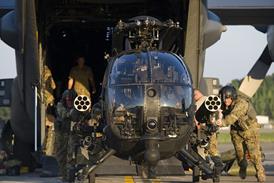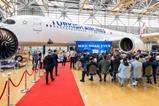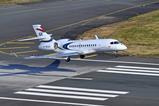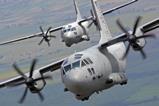Sikorsky is close to completing the preliminary design review (PDR) for its Hex tiltwing demonstrator, as it also begins building a power system testbed to evaluate the aircraft’s hybrid-electric powertrain.
Igor Cherepinsky, director of the Sikorsky Innovations unit, says the Hex demonstrator – details of which were disclosed at the HeliExpo show in February – is “on track”.

He says Sikorsky is “approaching PDR for the air vehicle – the dynamic system, blades, you know, things like that”.
In the meantime, the power system testbed is being constructed at the airframer’s site in Stratford, Connecticut, with power-on expected by year-end.
Comprising a steel frame to support the rotors, turbine engine and other key parts of the propulsion system, it will allow the company to test “the hybrid-electric system”.
A series hybrid design, it includes a CT7 engine from partner GE Aerospace coupled to a generator producing 1.2MW of electrical power. Sikorsky-designed motors, power electronics and a vehicle management system – to enable the transition from hover to forward flight – complete the set up.
“What happens after power-on depends on our findings but we are going pretty fast,” says Cherepinsky.
A first run of the system is expected “sometime next year”, he says. Testing will likely start in Stratford before the rig is moved to Sikorsky’s facility in West Palm Beach in Florida for additional ground runs and hover tests.
However, he says the “usual caveats” apply to the timeframe for the trials, adding: “This is our first foray into a really high-power hybrid system so we are going to make it as fast as possible without doing anything silly.”
Sikorsky intends to build two aircraft for the demonstrator campaign, the first of which will follow the testbed “by about six to eight months”.
But that “depends on our findings on the power system,” Cherepinsky says, noting that it has to test and mature the powertrain sufficiently that “I’m comfortable enough to put it in, you know, a not inexpensive 9,000lb [4,080kg] air vehicle and go fly that.”
Sikorsky is hoping to achieve a range exceeding 500nm (926km) at high speed with the Hex demonstrator, which will have a maximum take-off weight of 4,800kg.
Hex is part of a family of hybrid-electric aircraft concepts being developed by the rotorcraft stalwart.
Other designs include an uncrewed vertical take-off and landing rotor-blown-wing aircraft, a larger tiltwing, and a conventional helicopter.
The larger tiltwing, intended for civil or military applications, builds on the Hex concept and “is meant to be one of the first candidate products”, says Cherepinsky. Conceptual design activities for the aircraft have been completed, he adds.
“It is a very efficient vertical hovering machine but also a pretty fast aircraft for cargo or people.”
Meanwhile, Sikorsky continues to evaluate potential architectures for the “ultra-efficient, ultra-cost-effective” hybrid-electric helicopter.
“We are actively studying whether it’s a twin turbine, whether it’s a single turbine, where the batteries are, how one might go certify one of these aircraft,” he says.
“This is what we are aiming for our next product cycle; don’t expect us to talk about this for decades, expect to hear from us in a year [with a] more concrete commitment to something or other.”
But the airframer is also considering how to adapt the hybrid-electric system to equip in-service helicopters such as its S-92 heavy-twin, which Cherepinsky calls a “great platform for the application of hybrid technology”.
Retrofit kits for the S-92 are in development, he says “that will bring new capability” to the helicopter.































